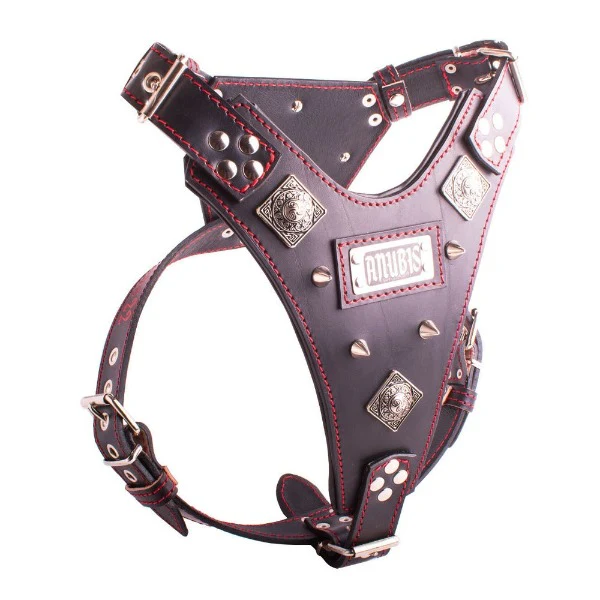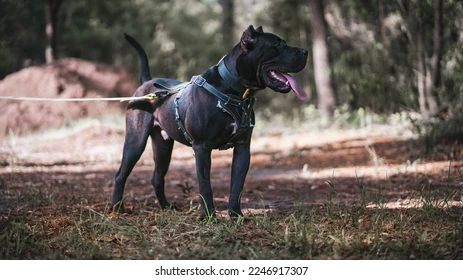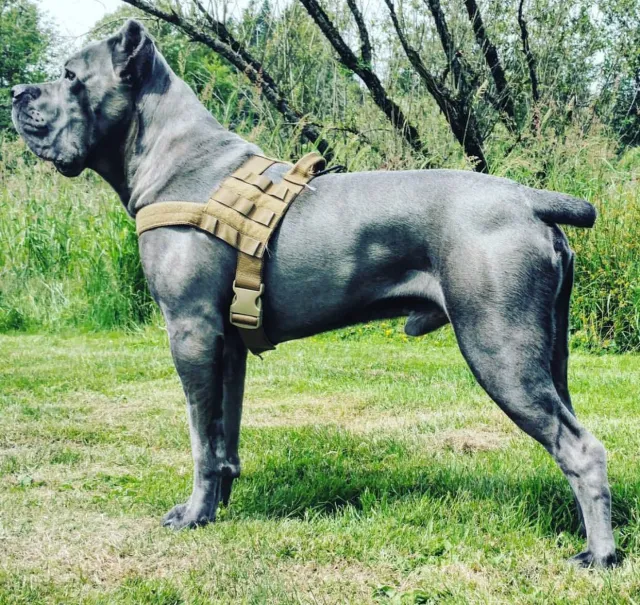- Introduction
- 1. Cane Corso Physical Characteristics
- 2. Types of Harnesses Recommended for Cane Corsos
- 3. Important Considerations for Cane Corso Harnesses
- Cane Corso Harness Guide
- 4. Historical Use of Harnesses for Cane Corsos
- 5. Comparison with Other Large Breeds
- Best Harnesses for Cane Corsos
- 6. Training with a Harness
- Conclusion
Introduction
The Cane Corso is a powerful, large breed that requires a harness designed for their strength and physicality. With a broad chest and muscular build, Cane Corsos need durable, comfortable harnesses that provide control without restricting movement. In this guide, we’ll explore the best harnesses for Cane Corsos, what to consider when choosing one, and how to ensure the harness fits properly for both walks and training.
By the end of this article, you’ll have a better understanding of what harness works best for your Cane Corso and why it's crucial for their safety and comfort.
1. Cane Corso Physical Characteristics
Understanding the physical attributes of a Cane Corso is essential when selecting the right harness.
- Weight: Cane Corsos typically weigh between 40-50 kg (88-110 lbs), meaning they need harnesses that can handle this weight.
- Height: Standing 58-70 cm (23-27.5 inches) at the shoulder, the Cane Corso's muscular frame and broad chest require a harness that provides proper support.
- Broad Chest: The wide, deep chest of the Cane Corso means harnesses should fit securely without restricting movement, especially around the shoulders.

2. Types of Harnesses Recommended for Cane Corsos

1. Wide-Chest Harnesses
For large dogs like the Cane Corso, wide-chest harnesses offer the best fit and support. These harnesses are designed to distribute pressure evenly across the chest, making them perfect for strong, active dogs.
- Broad Fit: A wide-chest harness ensures that the pressure from pulling or sudden movements is spread across the chest and not concentrated on the neck or shoulders.
- Comfortable for Daily Use: These harnesses are padded and built to prevent discomfort, making them ideal for walks and casual outings.

2. Working Harnesses with Handles
Working harnesses come with additional features like handles for better control, making them ideal for Cane Corsos involved in protection work or intensive training.
- Built-in Handle: These harnesses feature a handle on the back, allowing owners to control their Cane Corso in high-stress situations or during training.
- Durability for Working Dogs: Designed for strength and endurance, working harnesses are built to handle the physical demands of Cane Corsos in roles like protection or search and rescue.

3. No-Pull Harnesses
If your Cane Corso tends to pull on the leash, a no-pull harness is an effective solution. These harnesses are designed to discourage pulling by redirecting the dog’s attention back to the owner.
- Front Leash Attachment: The leash attaches to the front of the harness, causing the dog to turn slightly when they pull, reducing forward momentum and pulling behavior.
- Great for Training: No-pull harnesses are highly recommended for Cane Corso owners who want to train their dog to walk calmly without pulling.

3. Important Considerations for Cane Corso Harnesses
Cane Corso Harness Guide
Physical Characteristics
Recommended Harness Types
- Wide chest harnesses
- Working harnesses with handles
- No-pull harnesses
Special Considerations
- Need durable harnesses due to strength and size
- Harness should evenly distribute pressure to prevent injuries
- Choose a harness that doesn't restrict shoulder movement
Historical Context
Comparison with Other Large Breeds
- Require more robust harnesses than Labradors or Golden Retrievers
- Similar harness size to other mastiff breeds like Rottweilers
Training and Use
- Harness training typically begins at 8-10 weeks of age
- Special harnesses with handles and control points used for protection work
Strength and Durability
Given the strength and size of Cane Corsos, harnesses must be made from high-quality, durable materials like nylon, leather, or reinforced fabric.
- Strong Materials: Look for harnesses made of heavy-duty materials like nylon with reinforced stitching to withstand the pulling and force of a large dog.
- Metal Hardware: Choose harnesses with metal buckles and D-rings for added strength, as plastic buckles may not be able to handle the pressure.
Pressure Distribution
To prevent injury, a harness for a Cane Corso must distribute pressure evenly across the body.
- Wide Chest Straps: Ensure the harness has wide chest straps that distribute pressure evenly, especially during pulling or sudden movements.
- Avoid Restricting Movement: The harness should not restrict the shoulder movement of your Cane Corso, as this can lead to discomfort and injury.
Comfort and Fit
The harness should fit snugly without being too tight. A well-fitted harness ensures comfort and safety for your Cane Corso.
- Adjustable Straps: Look for harnesses with multiple points of adjustment to get the perfect fit for your dog.
- Padding: Harnesses with padded chest and back areas are ideal for preventing irritation and ensuring your Cane Corso’s comfort.
4. Historical Use of Harnesses for Cane Corsos
Hunting and Protection in Ancient Rome
Historically, Cane Corsos were used for hunting and protection in ancient Rome. They often wore leather harnesses designed to protect them while hunting large animals like wild boars.
- Leather Harnesses: These traditional harnesses were made from reinforced leather to protect the dogs during dangerous hunting expeditions.
- Strength and Endurance: The Cane Corso’s history as a working dog meant that their harnesses had to be durable enough to withstand tough conditions and heavy loads.

5. Comparison with Other Large Breeds
Best Harnesses for Cane Corsos
Wide-Chest Harness
- Distributes pressure evenly
- Comfortable for daily use
- Prevents neck strain
- Ideal for walks and casual outings
Working Harness
- Built-in handle for control
- Durable for intensive training
- Suitable for protection work
- Extra support for active dogs
No-Pull Harness
- Front leash attachment
- Discourages pulling behavior
- Great for leash training
- Helps maintain control on walks
Note: Always ensure the harness fits properly, allowing for comfortable movement without being too loose. Consider your Cane Corso's size (40-50 kg, 58-70 cm tall) when choosing a harness.
Stronger Than Labrador and Golden Retriever Harnesses
Cane Corsos require much more durable harnesses compared to medium-sized dogs like Labradors or Golden Retrievers due to their greater strength and size.
- Heavy-Duty Construction: While Labradors may use thinner, more flexible harnesses, Cane Corsos need harnesses made from tougher materials like leather or reinforced nylon to prevent damage during intense use.
Similar to Other Mastiff Breeds
The Cane Corso shares similar harness needs with other mastiff breeds like the Rottweiler, as both require wide-chest harnesses that provide support and control.
- Similar Size Requirements: Just like Rottweilers, Cane Corsos benefit from wide, padded harnesses that distribute pressure evenly across their chest and back.
6. Training with a Harness
Start Early: 8-10 Weeks (H3)
Training your Cane Corso to use a harness should begin as early as 8-10 weeks of age. Starting early helps them get accustomed to wearing a harness and allows for proper leash training.
- Gentle Introduction: Begin by letting your puppy wear the harness indoors for short periods, gradually increasing the time to ensure they’re comfortable.
- Leash Training: Once your Cane Corso is used to the harness, begin leash training to teach them not to pull and to respond to commands.
Special Harnesses for Protection Work
For Cane Corsos involved in protection work, special harnesses with handles and additional control points are used to provide better handling during training sessions.
- Handles for Control: These harnesses allow trainers to maintain control of the dog in high-stress situations or during intense training exercises.
- Built for Durability: Designed to handle the physical demands of protection work, these harnesses are made from reinforced materials to withstand heavy use.

Conclusion
Choosing the right harness for your Cane Corso is essential to ensure both control and comfort. Whether you’re looking for a wide-chest harness for daily walks, a no-pull harness for training, or a working harness for protection work, the key is finding a harness that fits well and supports your dog’s strength and activity level. By selecting the right harness, you can ensure your Cane Corso stays safe and comfortable while maintaining control during walks or training sessions.
Have You Found the Perfect Harness for Your Cane Corso? Share Your Thoughts!
Have you found the best harness for your Cane Corso, or do you have any recommendations? Share your thoughts and experiences in the comments below! For more detailed harness reviews, check out our Cane Corso Guide.


Leave a Reply